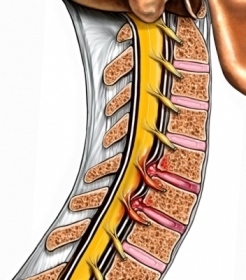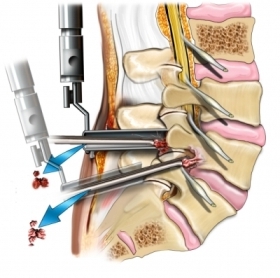Laminectomy – Removal of the vertebral arch
Description laminectomy
Laminectomy – surgery to remove a small portion of a vertebra in the spine. The removable part is called the vertebral arch.

Reasons for laminectomy
Laminectomy usually held, to relieve pressure on the spinal cord or nerves, othodyashih of the spinal cord. The operation is also performed to gain access to the spinal cord, bones, and drives, which are under the bow.
Rupture discs, bone spurs, or other problems can cause narrowing of the canals, through which the nerves and the spinal cord. This can irritate the nerve, if the channel is too narrow and compresses it. Often laminectomy performed with Remote Disc, to expand the canal and take pressure off the nerves.
When the spinal cord or other nerves are irritated, this can cause:
- Weakness;
- Numbness;
- Pain in the arm or leg.
Primarily used for the treatment of physical therapy and medication. Laminectomy performed, When these treatments are ineffective. She often held, if symptoms continue to worsen.
Possible complications laminectomy
Complications are rare, but no procedure does not guarantee the absence of risk. If you plan to laminectomy, you need to know about possible complications, which may include:
- Infection;
- Bleeding;
- Blood clots;
- Nerve Damage, which leads to the pain, numbness, tingling, or paralysis;
- Problems, associated with anesthesia.
Factors, that may increase the risk of complications:
- Other disease, especially heart disease or lung disease;
- Obesity;
- Advanced age;
- Smoking.
We need to discuss these risks with your doctor before surgery.
How is laminectomy?
Preparation for the procedure
Your doctor may carry out or assign the following:
- Medical checkup;
- Roentgen – test, using X-rays to take pictures of structures inside the body, especially bones;
- MRT – test, which uses magnetic waves, to take pictures inside the body;
- Myelogram – a specialized type of x-ray, which requires the introduction of dye into the region near the spinal cord, and shows, if there is pressure on the spinal cord or the nerves;
- CT scan – such as X-rays, which uses computer, to take pictures inside the body.
During preparation for surgery:
- If you are overweight, Try to lose weight. This will reduce the load on the spine;
- Talk to your doctor about taking any medications. Maybe, you have to stop taking aspirin or other anti-inflammatory drugs for one week before surgery. You may also need to stop receiving blood-thinning drugs, such as clopidogrel or warfarin;
- We need to organize a trip home and home care after surgery;
- The night before, you can have a light meal. Do not eat or drink anything the night before surgery.
Anesthesia
They can be used the following types of anesthesia:
- General anesthesia – blocks any pain and the patient support in a sleep state during operation. Administered intravenously in the arm or hand.
- Spinalynaya anesthesia – blocks pain in the lower body, from the chest down, the patient is awake. Was injected in the back.
Procedure laminectomy
If the operation is performed using minimally invasive techniques, It will be done a few small incisions. The doctor inserts the tiny surgical incisions. Vertebral arch is removed using a drill or other tools. When the vertebral arch was removed, the doctor can check the status of the spinal cord and discs, that were hidden under the bow.
In some cases, doctor conducts open surgery. The procedure involves creating a large incision in the skin in the problem area of the spine.
It is often necessary to remove the drive, as well as to remove pressure on the spinal cord. If the problem is not related to the position of the disc, the doctor will look for other problems, irritating nerves. In rare cases, it may be performed fusion – operation, which involves joining together two vertebrae. After the surgery, the incision will be sewn or stapled connected.

How long will laminectomy?
Duration of operation – 1-3 o'clock.
Laminectomy – Will it hurt?
The pain will be felt during the recovery process. The doctor will give pain medicine.
The average time of stay in the hospital after laminectomy
Laminectomy is performed in a hospital. Usually the duration of stay of 1-3 day. The doctor can extend the stay, if complications arise.
Care after laminectomy
Care in a hospital
During recovery in the hospital:
- It is recommended to start walking with assistance in the evening after surgery or the next day;
- Maybe, you have to wear a retainer for neck;
- It is recommended to wear special socks or boots. This will help to prevent blood clots.
Home Care
When you return home, Follow these steps:, to ensure the normal recovery:
- Be sure to follow your doctor's instructions;
- Keep the incision site clean and dry;
- Ask the doctor, when it is safe to shower, bathe, or to expose the surgical site to water;
- Do exercises for the legs, when you are in bed. This will help to improve blood circulation and reduce the risk of blood clots;
- Do not lift heavy objects;
- Work with a physical therapist. We need to gradually move from walking to the exercise with a low load, such as swimming;
- We need to take medication, recommended by the doctor. Check with your doctor receiving other drugs;
- Sutures or staples are removed within two weeks.
Contact your doctor after laminectomy
After discharge from the hospital need to see a doctor, If the following symptoms:
- Signs of infection, including fever and chills;
- Redness, edema, increased pain, bleeding, or discharge from the incision;
- Nausea and / or vomiting, which do not disappear after taking the prescribed medicines, and persist for more than two days after discharge from the hospital;
- Pain, which does not pass after taking pain medication appointed;
- Cough, breathlessness, chest pain;
- Problems with urination or defecation;
- Numbness or weakness in the thighs, groin or leg;
- Joint pain, fatigue, constraint, rash or other painful symptoms.
